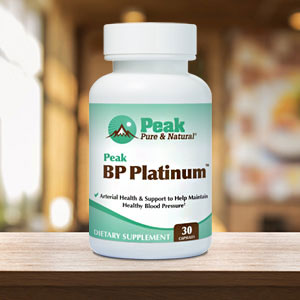Get Easy Health Digest™ in your inbox and don’t miss a thing when you subscribe today. Plus, get the free bonus report, Mother Nature’s Tips, Tricks and Remedies for Cholesterol, Blood Pressure & Blood Sugar as my way of saying welcome to the community!
Why blood pressure testing is mostly wrong

Approximately one-third of Americans are walking around with a potential time bomb in their body: high blood pressure.
Only about half (54%) of these 75 million individuals have their blood pressure under control.
In addition, about another 75 million Americans have prehypertension, which means their blood pressure is not quite in the high blood pressure range.
Because hypertension is a significant risk factor for cardiovascular disease and is also the number two greatest public health threat, getting an accurate measurement of blood pressure is critical. But are we? Recent findings have some experts asking, do we need to change how we measure blood pressure?
What is blood pressure?
Blood pressure is the force necessary to move blood through the arteries that exit the heart to deliver oxygen-rich blood throughout the body.
When you are told your blood pressure reading, the first number (systolic) is the highest pressure in your blood vessels while your heart is contracting. This number is an indication of how stiff your arteries are, and it’s important since arterial stiffness is a major risk factor for cardiovascular disease. The second number (diastolic) is the amount of pressure in the arteries between heartbeats when your heart is relaxed.
Experts have determined that high blood pressure is defined as systolic pressure equal to or greater than 130 mmHg and diastolic pressure equal to or greater than 80 mmHg. While this seems like a clear definition of high blood pressure, the numbers are useful only if your blood pressure has been measured accurately. Do you know if your blood pressure has been read accurately?
Do we measure blood pressure accurately?
Blood pressure can be measured in several different ways, but the approach the vast majority of people are familiar with is the use of a blood pressure cuff wrapped around the brachial artery in the upper arm. In some cases, blood pressure is taken using the femoral artery in the thigh, around the wrist (typically home blood pressure devices), or central aortic.
Of all the methods, the one believed to be the most accurate is the latter, because it provides information on the amount of pressure affecting the organs, including the brain. However, central aortic blood pressure measurements require an invasive technique to be performed.
In a recent study appearing in the Journal of the American College of Cardiology, a team of experts reviewed 74 studies that involved nearly 3,100 participants and involved measuring blood pressure using the popular cuff method, intra-arterial aortic BP and intra-arterial brachial BP. Overall, the authors found that:
- Cuff BP underestimated intra-arterial brachial systolic BP by a mean of -5.7 mmHg and overestimated intra-arterial aortic systolic BP by a mean of 5.5 mmHg.
- Cuff BP was reasonably accurate (accuracy up to 80%) for individuals with a blood pressure lower than 120/80 or those with a BP greater than 160/100.
- For individuals with systolic blood pressure between 120 and 159 mmHg and with diastolic values between 80 and 99 mmHg, accuracy declines to between 50 percent and 57 percent
They concluded that “Cuff BP has variable accuracy for measuring either brachial or aortic intra-arterial BP, and this adversely influences correct BP classification.”
Why blood pressure readings can be inaccurate
Several factors can affect the accuracy of a blood pressure reading and in some cases, more than one factor may be involved. For example:
- Size of the cuff. A cuff that is too small may cause the systolic reading to be 10 mmHg to 40 mmHg higher than it really is. The proper arm circumference should be visible on the cuff.
- Where the cuff is placed. The cuff should be positioned at heart level about 1 inch above the elbow bend and on bare skin, not over clothing. The sleeve of the shirt should be off and not rolled up, because blood flow can be affected.
- Hearing problems. If an individual is using a stethoscope to listen for changes in sounds in the brachial artery, A blood pressure reading may be inaccurate if the measurement is taken using a stethoscope and by an individuals who has some hearing loss.
- Calibration issues. Blood pressure devices, including home and automated machines, should be calibrated regularly to ensure accurate readings. Up to 15 percent of patients get an inaccurate blood pressure reading from home machines, according to one study.
- Body position. For the most accurate reading, you should be seated in a chair with your back supported, your feet flat on the floor, and your legs uncrossed for at least five minutes before the measurement is taken. Your arm also should be supported while you are seated.
- Activity. Certain activities can increase your blood pressure. For example, talking while having your pressure taken or having a full bladder both may raise your systolic pressure by 10 mmHg. You should not engage in any exercise for at least 30 minutes before having your pressure taken.
- Drug use. Intake of caffeine, alcohol, or nicotine should be suspended for at least 30 minutes before having your pressure measured.
- Seeing a doctor. For about 15 to 30 percent of people, seeing their doctor automatically causes their blood pressure reading to rise temporarily. This is known as white coat hypertension.
Health risks associated with low or high blood pressure
Abnormally low blood pressure can be caused by a number of factors, such as pregnancy, loss of blood, endocrine problems, nutritional deficiencies, and prolonged bed rest. Symptoms associated with low blood pressure can include:
- Dizziness
- Nausea
- Problems with concentration
- Fainting
- Blurry vision
- Cold, clammy skin
- Fatigue
- Unusual thirst
- Rapid, shallow breathing
High blood pressure typically is not accompanied by symptoms. In fact, the first indication of hypertension may be a heart attack or stroke. Having high blood pressure increases your risk for developing kidney disease, cardiovascular disease, vision loss, sexual dysfunction, and stroke.
How to assess blood pressure risk without a cuff
If you want to assess your risk of high blood pressure without using a cuff or seeing your doctor, the waist-to-hip ratio is an option. The idea is that if you have more fat around your waist than you do on your hips, you may be at an increased risk for obesity-related hypertension.
Take a measurement of your hips at the widest part and your waist at the smallest part (immediately above the belly button). Then divide your waist measurement by your hip measurement, and the resulting ratio indicates your risk of hypertension.
For example: a value of 0.9 or higher places men at risk for hypertension. Values less than 0.85 means a man is in excellent shape regarding hypertension risk, while values in between indicate good to average condition.
Lifestyle changes key to lower blood pressure
Lifestyle modifications, rather than hypertension medications, are the key to lower blood pressure. This is the message more and more doctors need to pass along to their patients, along with guidelines on how to make those necessary changes. Among the most important lifestyle changes one can make are diet and exercise, although stress reduction, not smoking, and adequate sleep are also significant factors.
For example, the standard American diet is high in carbohydrates (especially sugar and fructose) and processed foods, both of which result in an overproduction of leptin and insulin and a rise in blood pressure. High levels of uric acid (associated with red meat, alcohol, turkey, some fish and seafood) also are associated with hypertension.
Another issue related to diet is the fact that high blood pressure is a symptom of the body’s resistance to leptin and insulin. A resistance to insulin, for example, elevates blood pressure because insulin helps the body store magnesium, a mineral that relaxes muscles. When cells are resistant to insulin, magnesium can’t be stored properly, resulting in blood vessel constriction and elevated blood pressure.
Leptin is a hormone that helps make us feel full via signals to the brain. However, for people with leptin resistance, the brain doesn’t realize when there is enough leptin circulating in the body, so you may not feel satiated and keep on eating, which can result in obesity and raised blood pressure. Ways to reverse leptin resistance is to avoid processed foods (especially those with added sugars, trans fats, and sodium), exercise regularly, and get plenty of soluble fiber.
Other dietary actions you can take to help lower blood pressure are:
- Focusing on locally grown, organic, unrefined foods
- Swapping simple or starchy carbs for healthy fats, such as avocados, coconut oil, raw nuts, grass-fed meats or pasture-raised poultry, and unheated organic nut oils. Sugars and starches elevate insulin and leptin levels, which can promote high blood pressure
- Practicing intermittent fasting, which is an effective way to normalize leptin/insulin sensitivity. Intermittent fasting can be done in a variety of ways. One way is to eat all of your calories during a specific period of time each day and fasting the rest of the time; for example, all food is consumed between 10 AM and 2 PM and you don’t eat (except for water and/or fluids) until 10 AM the next day. You also can explore other ways to practice intermittent fasting. The body is most sensitive (and thus less resistant) to insulin and leptin following a period of fasting.
Regular exercise is another important way to help normalize blood pressure. One unique exercise that takes only three minutes and will safely lower blood pressure is the nitric oxide dump exercise. It involves four basic movements that are done in rapid succession over a three-minute period two to three times a day. This exercise session stimulates the release of nitric oxide, which in turn lowers blood pressure by relaxing and dilating your blood vessels, improving immune system function, reducing the thickness of your blood, and boosting lean body mass. While doing this exercise — and all exercises — focus on breathing through your nose rather than your mouth. Mouth breathing can promote high blood pressure and fatigue.
Note: If you are taking medication to treat high blood pressure, work closely with your doctor as you adopt healthful lifestyle modifications. Do not make any medication changes without medical guidance.
Medical treatment for high blood pressure
More than 100 drugs are available to treat high blood pressure, and all of them are associated with at least a few side effects, some of which are more serious than others. Among the most commonly prescribed drugs for high blood pressure include:
- Beta-blockers (e.g., acebutolol, atenolol, carteolol, among others), which lower blood pressure by dilating blood vessels. Side effects may include stomach cramps, diarrhea, nausea, vomiting, rash, blurry vision, headache, and depression, among others.
- Diuretics, also known as water pills. Several groups of medications are in this broad category, including those that spare or don’t spare potassium. Examples of diuretics are chlorthalidone, hydrochlorothiazide, bumetanide, furosemide, and amiloride, among others. Some side effects are headache, dizziness, thirst, increased blood sugar levels, muscle cramps, and rash, among others.
- Calcium channel blockers, which relax the muscle cells in blood vessel walls. Examples of calcium channel blockers include diltiazem, felodipine, nicardipine, and nifedipine. Some side effects include dizziness, edema, nose bleeds, rash, and ringing in the ears, among others.
You can start to take control of your blood pressure by monitoring it at home. When using a home BP monitoring device, be sure you take your blood pressure reading at the same time each day and to always take it on the same arm. Talk with a knowledgeable professional (e.g., doctor, nurse, pharmacist) to ensure you are using the device correctly.
The new gold standard for detecting hypertension and pre-hypertension is through the measurement of the central pressures, which the heart, brain, and kidneys actually experience, and is, in almost all cases if elevated, a measure of systemic arterial stiffness. Currently adopted by specialists including cardiologists and research institutions, the SphygmoCor® system is being expanded into use by more and more health and naturopathic professionals.
Editor’s note: Have you heard of EDTA chelation therapy? It was developed originally to remove lead and other contaminants, including heavy metals, from the body. Its uses now run the gamut from varicose veins to circulation. Click here to discover Chelation: Natural Miracle for Protecting Your Heart and Enhancing Your Health!
Sources:
- Mercola J. Blood pressures testing is mostly inaccurate. 2017 Aug 9
- Oaklander M. Your home blood pressure monitor might be way off. Time 2014 Oct 28














